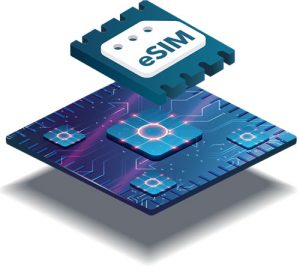eSIM Technology
eSIM (embedded SIM) technology is becoming increasingly popular around the world, allowing people to connect their devices to the internet using a digital SIM card instead of a physical one. In this article, we’ll explore what eSIMs are, how they work, their benefits and drawbacks, and what the future holds for this technology.
What is eSIM?
An eSIM is an embedded SIM that is integrated into the device’s hardware. Unlike a traditional physical SIM card, an eSIM doesn’t require physical swapping, and it can be programmed to work with multiple networks.

eSIMs are already widely used in many devices such as smartwatches, tablets, and laptops, but they’re also increasingly popular in smartphones. Instead of having a physical SIM card slot, devices with eSIMs use a small chip that is pre-installed by the manufacturer.
How does eSIM work?
The eSIM works like a traditional SIM card, allowing the device to connect to cellular networks, but instead of a physical card, it is built into the device’s hardware. An eSIM is programmed to work with a particular carrier network or multiple carriers, depending on the manufacturer.
To activate an eSIM, you need to scan a QR code provided by your carrier or enter the details manually. The activation process is relatively quick and straightforward and can be done remotely without requiring a physical SIM card.
What are the benefits of eSIM?
eSIMs offer several benefits over traditional physical SIM cards. Here are some of the most significant advantages:
- Convenience – With eSIM, you don’t need to swap out physical SIM cards when changing carriers. You can easily switch carriers or data plans by scanning a QR code or entering the details manually.
- Flexibility – An eSIM allows you to use multiple carrier profiles on the same device, which is great for those traveling frequently or using different networks in different locations.
- Space-saving – Since eSIMs are built into the device’s hardware, it eliminates the need for a physical SIM card slot. This frees up space for other components, making devices thinner and more compact.
- Security – eSIMs are tamper-proof and more secure than traditional SIM cards, which can be removed or swapped out easily.
- Cost-effective – With eSIM, you don’t need to pay for a physical SIM card, saving you money in the long run.
What are the drawbacks of eSIM?
While eSIM technology offers many benefits, there are also some drawbacks to consider:
- Limited device compatibility – Not all devices support eSIMs yet, and not all carriers offer eSIM plans. This means you may be unable to use an eSIM with your device or carrier.
- Device lock-in – Some carriers may lock your eSIM to their network, making switching carriers or using a different device difficult.
- Activation process – While the activation process for eSIM is relatively straightforward, it can be more complicated than traditional SIM cards, requiring you to scan a QR code or enter details manually.
- Lack of physical card – Some people prefer the reassurance of having a physical SIM card in case of emergency, which isn’t possible with eSIM.
What’s the future of eSIM?
The future of eSIM technology looks bright, with more devices and carriers adopting this technology. As 5G networks become more prevalent, eSIMs will become even more important, allowing for faster connectivity and more advanced features.
eSIM technology will also enable more connected devices, such as wearables and smart home devices, to connect to cellular networks. This will allow for more seamless integration between different devices and the internet, making our lives more connected and convenient.
Conclusion eSIM technology is transforming the way we connect our devices
eSIM Technology faq
Q: What is an eSIM?
A: An eSIM, or embedded SIM, is a digital SIM card that is embedded in a device and cannot be removed physically. It allows users to activate a cellular plan without needing a physical SIM card.
Q: How does an eSIM work?
A: An eSIM works by storing subscriber identity information electronically and transmitting it to the cellular network. It uses a technology called Remote SIM Provisioning (RSP) to download the necessary profile information from the network operator over the air.
Q: What are the advantages of eSIM technology?
A: The advantages of eSIM technology include the ability to activate a cellular plan remotely, the ability to switch carriers without needing a physical SIM card, and the ability to have multiple cellular plans on a single device.
Q: Which devices support eSIM?
A: eSIM technology is supported by a growing number of devices, including smartphones, tablets, smartwatches, laptops, and IoT devices. Some popular devices that support eSIM include the iPhone, iPad, Google Pixel, Samsung Galaxy, and Microsoft Surface.
Q: How do I activate an eSIM?
A: To activate an eSIM, you typically need to contact your mobile network operator and provide them with your device’s electronic SIM ID (EID). They will then send you a QR code that you can scan with your device’s camera to download the necessary profile information.
Q: Can I have multiple eSIMs on one device?
A: Yes, one of the advantages of eSIM technology is that it allows you to have multiple cellular plans on a single device. This can be useful for people who travel frequently or who need to separate work and personal phone lines.
Q: Can I use eSIM technology with any carrier?
A: Not all carriers support eSIM technology, but its adoption is growing. To find out if your carrier supports eSIM, you should contact them directly or check their website for information.
Q: Is eSIM technology secure?
A: eSIM technology uses encryption to protect subscriber identity information, and it is considered to be as secure as physical SIM cards. However, as with any technology, there is always a risk of security breaches, so it is important to use best practices such as setting strong passwords and keeping your device up to date with security patches.

